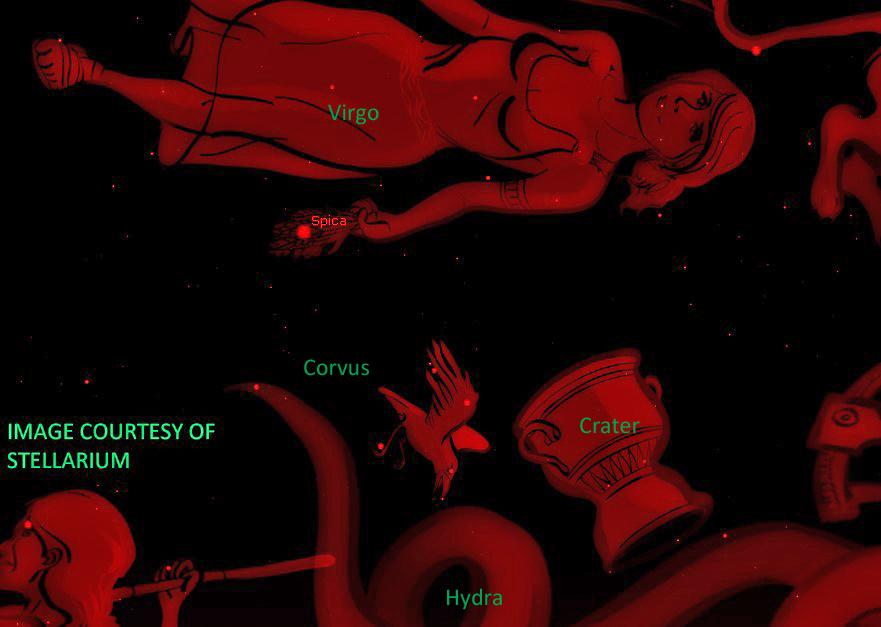
FIND THE CROW
This month, I will focus on one of my favorite constellations. Small in size and possessing no particularly bright stars, Corvus the Crow nonetheless stands out in the sky because of its distinctive boxy shape.
To find Corvus, note the bright star Spica, about halfway up in the south in the early evening at this time of year. The four brightest stars of Corvus make up sort of a squashed box shape to the lower right of Spica. A dimmer beak star and tail star are close to the upper left and lower right star in the box, but might need binoculars to be glimpsed if you have too many city lights, too much moonlight, or it’s a hazy night. With some imagination or perhaps your favorite refreshment, you might glimpse a bird here. Spica is supposed to be an ear of wheat, guarded by the maiden Virgo, from the hungry bird.
If you aren’t sure about the identifications, a sure way to tell is to go all the way back to the Big Dipper, high in the north. Follow the arc of the Big Dipper’s handle to the very bright yellowish orange star Arcturus, speed on or some say spike to Spica, and then continue to Corvus. See my April 2019 blog entry for more details about this old stargazer’s saying.
Corvus has a large amount of mythology associated with it for being one of the smallest constellations in the sky. These stars were originally supposed to represent a raven instead of a crow, and in Greek stories were often linked to Apollo, the sun god. In one story, Apollo had Corvus watch over his lover Coronis. When the bird reported that Coronis had been less than faithful, Apollo in his rage blamed the messenger and scorched his feathers, permanently changing the color of all ravens.
In another story, Apollo sent Corvus with his favorite cup in order to fetch some water. The bird paused to eat some figs and seemed to forget all about his mission. He finally remembered and returned with a watersnake in his claws, claiming that this was the cause of the delay. Apollo saw through the lie and placed all of them in the sky, with the snake forever guarding the cup, ensuring that Corvus would always be thirsty. Hydra, the watersnake and Crater, the Cup are dim constellations that require very dark skies to trace out.
Corvus is also special to me because it can be a guide to other sights in the sky. One time, while I was down in south Florida, I searched straight down to the southern horizon, formed by the waters of the Gulf of Mexico. It must have been a super-clear night, and just barely, I was able to make out all of the stars that make up the famous Southern Cross- the only time I have seen it all from the Northern Hemisphere.
Go to the Gateway Arch NPS Facebook page for frequent updates from our Sky Ranger about celestial events. Don’s miss our next Gateway to the Stars event at 8 pm on Saturday evening, June 27, featuring “Finding the Way with Lewis & Clark” by former Missouri Department of Conservation presenter Ken Porter. There will also be a virtual tour of the night sky by our Sky Ranger, and hopefully, live video telescope viewing. These events will be streamed via Facebook Live- check back closer to the event date for more details.
